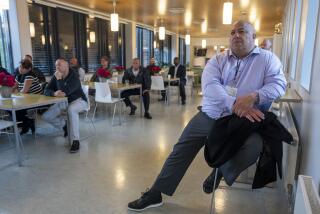Tiny Center Runs Sea Rescues Worldwide
- Share via
SOLA, Norway — Sitting at a bank of radios and phones, Ole Vaage helps save hundreds of people on the other side of the planet--on a good day.
On a bad day, the last words of someone he loses echo in his mind for hours.
“You can be talking to someone. Then the radio goes silent and you realize their boat sank and they are dead,” said Vaage, rescue leader at the Rescue Coordination Center-Southern Norway.
He seldom sees the people he does save from his post in this small town in southwestern Norway. Many are in waters thousands of miles away.
The center monitors satellite radio signals worldwide. When it picks up a distress call, it tries to contact ships in that area.
“We don’t actually rescue people. We send messages to ships or people in an area, and they do the job for us,” Vaage said.
When a ship sends a distress call, it is picked up by a satellite and bounced back to Earth. Since vast areas of the world’s oceans have no dedicated rescue center, the Sola center took up the job by default.
“The center that picks up the call first is the rescue leader,” said Vaage, a former navy officer.
For example, the Achille Lauro cruise ship, with 1,000 people aboard, was in the Indian Ocean off Africa when it caught fire in November 1994.
The Norwegian center picked up the mayday call and directed ships to the site, saving almost everyone aboard before the ocean swallowed the crippled liner, which already was infamous for a hijacking by Arab terrorists in 1985.
An American television network called the center seeking details on the rescue. The callers apparently did not realize the ship was near the equator, while the rescue center is only 550 miles from the Arctic Circle.
“They asked when we expected the passengers to reach Norway,” said Anders Bang-Andersen, the center’s spokesman. “I said we hoped the passengers might visit Norway someday, but that right now we were only concerned with getting them to land in Africa.”
Manned around the clock, the center averages 10 people saved a day. Last year, the center’s 13 permanent employees--usually two to a shift--directed about 250 rescues in distant waters. It handled an additional 3,500 in the waters close to home as well as on land in Norway.
The center was established by Norway’s government in 1970. It was set up to coordinate rescue units of the navy, coast guard, police, hospitals, offshore oil industry and volunteer groups, rather than having each operate on their own as in most rescue centers. In a disaster, reinforcements come from all the agencies.
“You start with a blank sheet. You don’t know what resources are there. You have to remain calm. The first thing you have to do is try to control the chaos,” said Vaage.
A recent shift gave a hint at what the center’s staff faces. Vaage, with a telephone seeming grafted to his ear, coordinated searches for a lost family in Norway’s mountains and for a fisherman missing from a small boat, and sent navigation warnings to ships off the U.S. East Coast.
That, he said, was a quiet shift.
It’s not a job you leave at work.
“After you go home, sometimes you just have to call in to see how it went,” said Vaage. The payback, he said, “is a lot of thank-you letters.”
More to Read
Sign up for Essential California
The most important California stories and recommendations in your inbox every morning.
You may occasionally receive promotional content from the Los Angeles Times.










